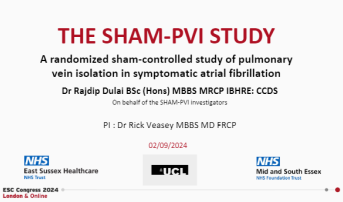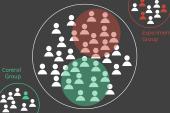SHAM-PVI: Catheter Ablation Improves Objective Measure of AF Burden
(UPDATED) Though there are limitations, the sham-controlled trial shows “no clinically relevant placebo effect,” a researcher says.

LONDON, England—The impact of pulmonary vein isolation (PVI)—the mainstay of catheter ablation for atrial fibrillation (AF)—should not be attributed to placebo effects, according to the SHAM-PVI trial.
Cryoablation reduced AF burden measured on implantable loop recorders by 75% through 6 months of follow-up compared with a sham procedure, with accompanying improvements in arrhythmia-related symptoms and quality of life, Rajdip Dulai, MBBS (University College London, England), reported here at the European Society of Cardiology Congress 2024.
At a press conference, he said the findings, published simultaneously online in JAMA, indicate “no clinically relevant placebo effect with pulmonary vein isolation.”
Since prior trials without a sham control, like CABANA, have demonstrated that catheter ablation for AF mostly improves symptoms and quality of life—without influencing rates of harder outcomes like stroke and death—there has been some question about whether significant placebo effects have been at play.
Even so, there are an estimated 50,000 to 75,000 AF ablations performed each year in Europe and the United States, Dulai noted. And ablation has gained strong recommendations in practice guidelines. The latest guidelines from the US and Europe, for example, include a class 1 recommendation stating that ablation is useful as a first-line therapy to improve symptoms and reduce disease progression in selected patients.
“The results of this study provide reassurance that pulmonary vein isolation works,” Dulai said.
Commenting for TCTMD, Nazem Akoum, MD (University of Washington Medical Center, Seattle), a member of the American College of Cardiology’s Electrophysiology Council, pointed out that some members of the electrophysiology community have been calling for sham-controlled trials to rule out placebo effects, and said that on that background, the results of SHAM-PVI “confirm that ablation works essentially.”
The impact on objectively measured AF burden is consistent with what was seen in the CIRCA-DOSE trial comparing cryoballoon and radiofrequency ablation, with the quality-of-life improvements similar to the effects demonstrated in other trials of ablation, he said.
There are some limitations of SHAM-PVI, Akoum said, “but I think notwithstanding these, the question about the placebo effect and the impact of PVI in A-fib patients has been settled.”
Secondary Outcomes All Favor Ablation
Though there are other sham-controlled studies of PVI in patients with AF underway, SHAM-PVI is the first to report results.
The trial, conducted at two tertiary centers in the United Kingdom, included 126 patients (mean age 66.8; 71% men) referred for catheter ablation. All had symptomatic paroxysmal or persistent AF despite treatment with at least one class I or III antiarrhythmic drug (AAD), or who were intolerant to AADs. The median time from first AF diagnosis was about 2 years. Most patients (79%) had persistent AF.
The investigators randomized sedated patients to PVI using a 28-mm cryoballoon catheter (Medtronic) or to a sham procedure that involved phrenic nerve pacing to simulate a real ablation; patients in both arms received direct current cardioversion if they were in AF at the time of the procedure. All participants had an implantable loop recorder (Reveal LINQ; Medtronic), which was set to record AF episodes lasting longer than 2 minutes, placed at least 2 weeks before the procedure.
The results of this study provide reassurance that pulmonary vein isolation works. Rajdip Dulai
Assessed at discharge after the initial procedure, the researchers found that the blinding protocols were “near perfect,” Dulai said. Although there was a loss of blinding over time—likely because of the effects of treatment, or the lack thereof—“half of all patients were still unable to guess their treatment allocation,” he and his colleagues report in their paper.
The primary endpoint of the trial was AF burden at 6 months, as measured on the loop recorders, after excluding a 3-month blanking period. At baseline, mean AF burden was similar in the ablation and sham arms (78.5% vs 78.2%), but by 6 months, it was much lower in the ablation-treated patients (18.2% vs 43.2%; P < 0.001).
Several secondary outcomes favored ablation as well. At 6 months, the mean score on the Atrial Fibrillation Effect on Quality of Life (AFEQT) questionnaire was 18.4 points higher, indicating less AF-related disability, after ablation versus sham. There was an advantage for the intervention on each of the AFEQT subdomains, too—symptoms (+13.7 points), daily activities (+23.2 points), and treatment concerns (+10.7 points). Changes of at least 5 points are considered clinically important.
Scores on the 36-item Short Form Health Survey, an assessment of overall quality of life, improved in the ablation arm and worsened in the sham arm. The estimated difference in general health score was 9.27 points at 6 months, with benefits seen across all subscales.
In addition, severity and frequency scores on the Mayo AF-Specific Symptom Inventory indicated positive changes after ablation.
In terms of other interventions, there was no significant difference in the number of repeat cardioversions performed during follow-up, with 39.7% of ablation-treated patients and 48.4% of sham-treated patients receiving one during the 3-month blanking period. Between 3 and 6 months, those who underwent ablation were less likely than those in the sham group to restart class I or III AADs (32.2% vs 54.1%).
One patient, in the sham group, died during the study. It was caused by an intracranial hemorrhage that occurred at 2 months and was deemed unrelated to study procedures. As for safety in the ablation arm, there were three events: one case of postprocedural pericarditis, one case of an aortic pressure tracing on transseptal puncture without additional adverse effects, and one case of transient leg weakness/numbness related to lidocaine.
Some Limitations
Dulai et al acknowledge that there are some limitations of the study, including the short, 6-month follow-up duration. “There may be regression to the mean with a longer follow-up, but this would not be due to a placebo effect but rather treatment failure due to disease progression or nondurable PVI,” they write.
In addition, the investigators assessed the effects of PVI alone—without adjunctive ablation techniques—and the study was conducted at only two centers.
Akoum pointed to other issues as well, noting that most prior AF ablation trials examined arrhythmia recurrence—rather than burden—as an endpoint. He added, however, “I think burden in this setting is actually appropriate, so I'd look at it more of a strength rather than a limitation.”
The length of follow-up is relatively short in the context of a patient’s lifetime, Akoum said, “but withholding therapy for longer than that in a control arm, which is sham, may not be clinically feasible and also may be questionable ethically in terms of not treating them and letting the substrate progress to a harder-to-treat substrate down the line.”
An additional limitation is the relatively abbreviated period that was used to establish AF burden at baseline. That time, between insertion of the loop recorder and the procedure, could be as short as 2 weeks, “which may not give you the full picture of that burden, especially in a paroxysmal A-fib patient,” Akoum said.
Nevertheless, SHAM-PVI was well designed and executed, with sufficient power to answer the question and no crossovers between arms, he said.
What the results indicate “is that waiting on A-fib to get better by itself without intervention is the wrong message to send to cardiologists or primary care providers that are taking care of these patients,” Akoum said. “The burden will increase, the patient's quality of life might get worse, and offering them the chance to be treated will allow them to have a lower AF burden with all of the associated implications in terms of stroke or heart failure that have both been tied to this endpoint, and also quality of life and symptoms in general.”
The study was not designed to assess effects on clinical outcomes like stroke, MI, or cardiovascular hospitalization, which would require a longer follow-up, Dulai said. He noted, however, that there were no strokes or procedure-related deaths observed.
Overall, he said, “I think the results are definitive.”
End of the Road?
Nikolaos Dagres, MD (Deutsches Herzzentrum der Charité, Berlin, Germany), served as the discussant following Dulai’s presentation. He acknowledged his conflict as a coordinating investigator for another ongoing sham-controlled trial of ablation, called PVI-SHAM-AF, before calling for more such trials.
He cited prior research demonstrating that “placebo and even nocebo effects are powerful, pervasive, and common in clinical practice,” pointing out that there are few randomized trials of invasive cardiovascular interventions that have a sham control. Those that have been done, such as ORBITA and a trial of percutaneous laser myocardial revascularization, have helped improve the understanding of diseases and the impact of various interventions, he said.
For PVI specifically, sham-controlled trials are critical because the main indication for doing the procedure is symptomatic relief, a subjective endpoint, Dagres said.
He said there are two main questions to consider when thinking about such a trial of catheter ablation: is it feasible and is it ethical? The completion of SHAM-PVI answers the first question.
As for the second, “we always hear the argument it's not ethical to perform a sham-controlled PVI study,” Dagres said. “I would revert that question and would ask, is it ethical to perform hundreds of thousands of procedures every year without definite, conclusive proof of a benefit exceeding a sham effect?”
Is it ethical to perform hundreds of thousands of procedures every year without definite, conclusive proof of a benefit exceeding a sham effect? Nikolaos Dagres
He credited SHAM-PVI as a “big step forward” in this area, but added, “I do not think that this is the end of the road.”
Additional trials using improvements in symptoms and quality of life as primary endpoints—since those are main indications for ablation—are needed, as are studies with larger numbers of patients treated across multiple centers, with a greater proportion of participants with paroxysmal AF, and using additional energy sources for PVI, he said.
Overall, though, “this is really strong evidence that is provided by our UK colleagues,” Dagres said.
Speaking with TCTMD, Stylianos Tzeis, MD, PhD (Mitera Hospital, Athens, Greece), lead author of a recent multisociety consensus statement on catheter and surgical ablation of AF, said SHAM-PVI provides “another piece of evidence that catheter ablation is really effective.”
He stressed, however, that there was already robust evidence supporting the safety and efficacy of ablation, which is reflected in strong guideline recommendations, adding that he’s not convinced additional sham-controlled trials are necessary.
“To be honest, I'm not sure that this will significantly increase the referrals for ablation because I strongly believe that the cardiological community has been persuaded about the value of catheter ablation,” he commented.
Todd Neale is the Associate News Editor for TCTMD and a Senior Medical Journalist. He got his start in journalism at …
Read Full BioSources
Dulai R, Sulke N, Freemantle N, et al. Pulmonary vein isolation vs sham intervention in symptomatic atrial fibrillation: the SHAM-PVI randomized trial. JAMA. 2024;Epub ahead of print.
Disclosures
- The study was supported by an unrestricted research grant from the Eastbourne Cardiology Research Charity Fund. Unrestricted in-kind support (implantable loop recorder devices) was provided by Medtronic.
- Akoum and Dulai report no relevant conflicts of interest.
- Dagres reports being a coordinating investigator for another sham-controlled trial of PVI.






Comments